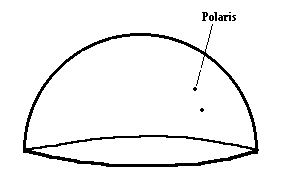

The earth rotates ... changing the sky on a daily cycle. (animation)
The day/night cycle - As you know, the sun rises in the east and sets in the west. This apparent motion of the sun across the sky is one example of diurnal motion (meaning daily motion). The early Greeks adopted a model where the earth remained stationary and the sun did the moving. But children now learn in kindergarten that the earth rotates on its axis ... making the sun appear to move across the sky. For the same reason, the moon rises and sets each day. In fact, the careful observer will notice that stars rise and set for the same reason. All because the earth is spinning once every 24 hours (actually 23h 56m 04.0905s) on its axis.
Because the earth is rotating on its axis, the sky is always changing. During the course of one day, the entire celestial sphere appears to make one complete "orbit" around the sky. The center of this motion is the north celestial pole (which appears to be "fixed" in the sky). Polaris (also known as the North Star) just happens to lie within 1 degree of the true pole. This is close enough to say that Polaris is the only object in the sky that does not appear to move within a 24 hour period.

The sky appears to spin around Polaris in this animation. (animation)
This leads to some interesting effects ... namely:
If an object is close to Polaris, its diurnal "orbit" may not intersect the horizon and it never rises or sets! These regions are called circumpolar regions. Some very familiar constellations are circumpolar for observers in Milwaukee ... The "Big Dipper" is circumpolar and can be seen any given night in Milwaukee.
Circumpolar region in Milwaukee
 (animation)
(animation)
If possible, please view a 93 kb movie in AVI format
which shows stars moving parallel to the horizon at the North Pole by clicking
here.
 (animation)
(animation)
If possible, please view a 99 kb movie in AVI format which shows stars rising at the equator by clicking here.
ŠJim Mihal 2004 - all rights reserved